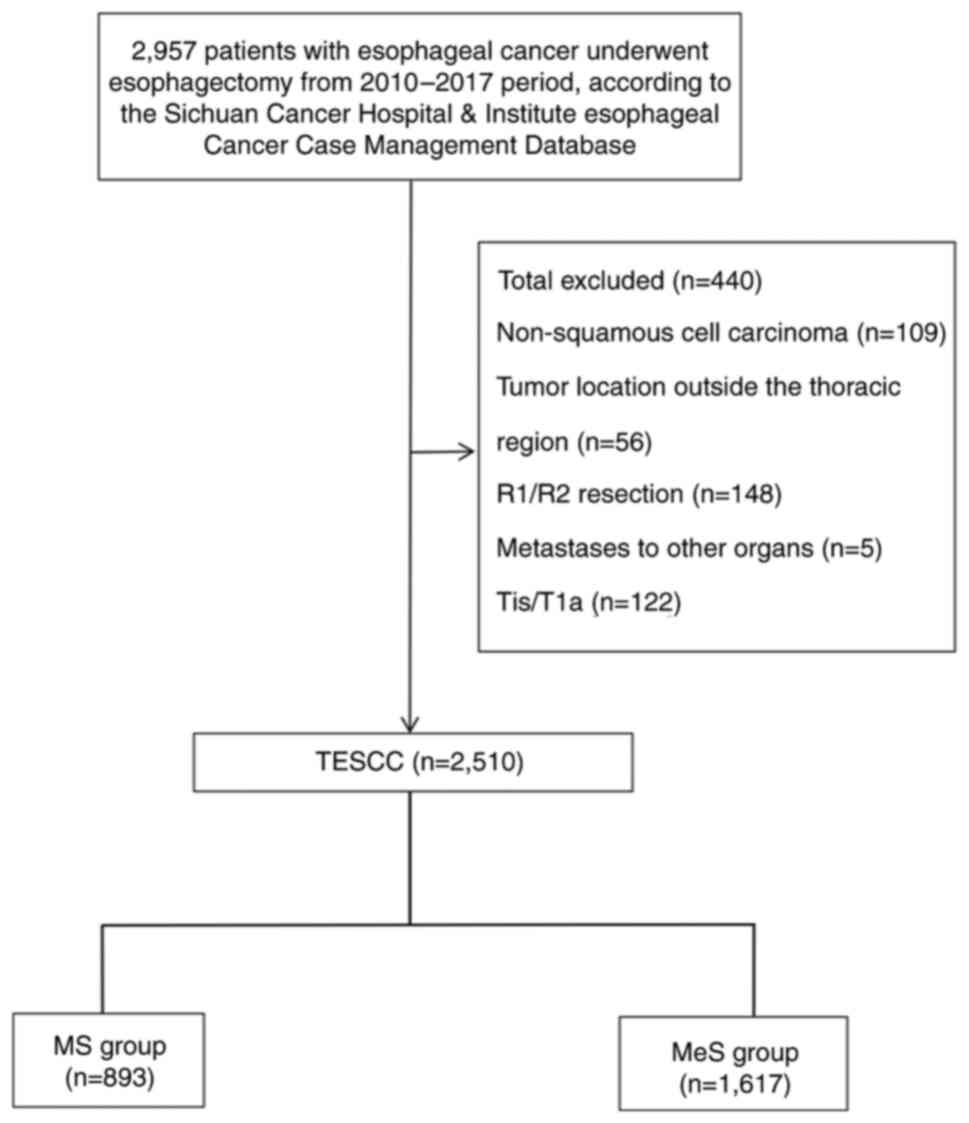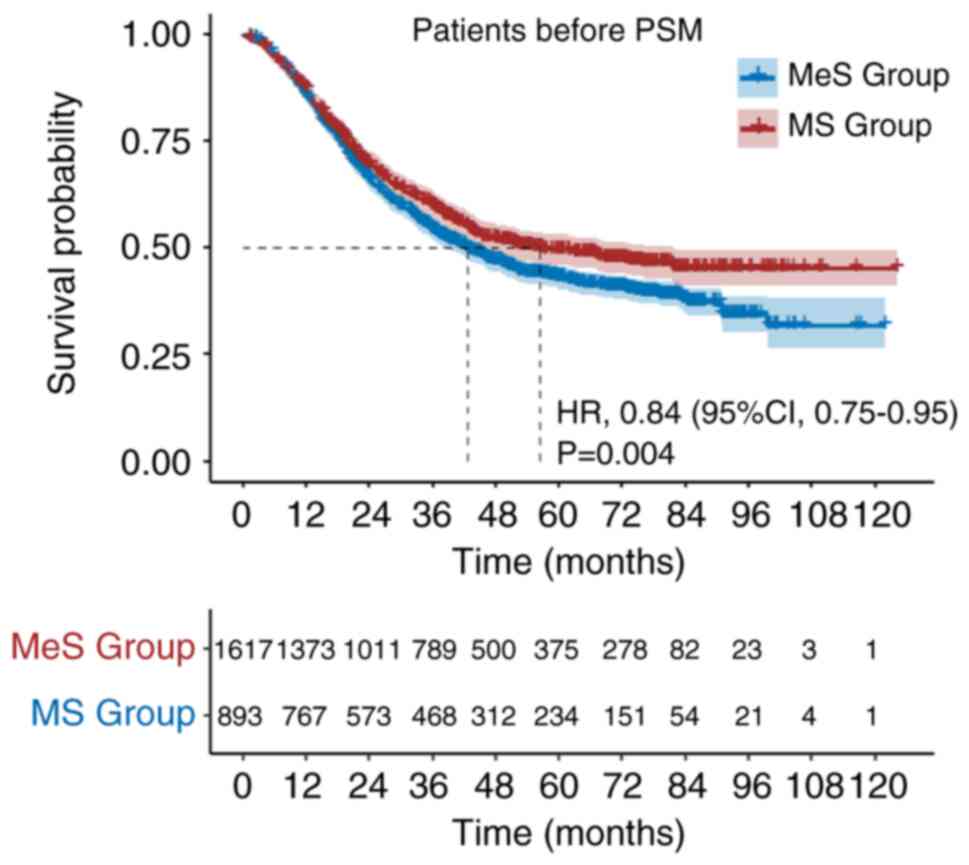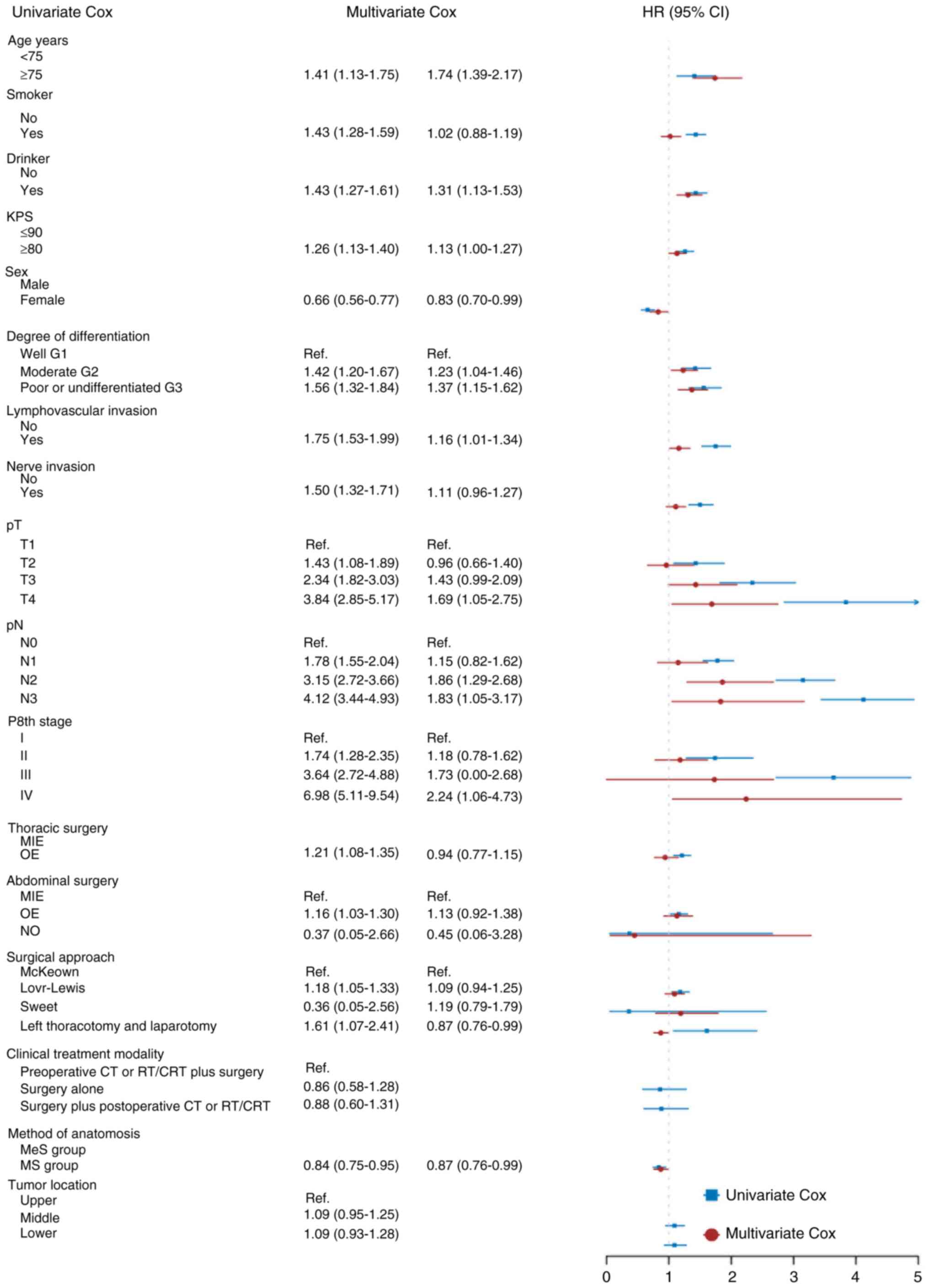|
1
|
Frick C, Rumgay H, Vignat J, Ginsburg O,
Nolte E, Bray F and Soerjomataram I: Quantitative estimates of
preventable and treatable deaths from 36 cancers worldwide: A
population-based study. Lancet Glob Health. 11:e1700–e1712. 2023.
View Article : Google Scholar : PubMed/NCBI
|
|
2
|
Zheng RS, Chen R, Han BF, Wang SM, Li L,
Sun KX, Zeng HM, Wei WW and He J: Cancer incidence and mortality in
China, 2022. Zhonghua Zhong Liu Za Zhi. 46:221–231. 2024.(In
Chinese). PubMed/NCBI
|
|
3
|
Siegel RL, Miller KD, Wagle NS and Jemal
A: Cancer statistics, 2023. CA Cancer J Clin. 73:17–48. 2023.
View Article : Google Scholar : PubMed/NCBI
|
|
4
|
Li K, Nie X, Li C, He W, Wang C, Du K, Li
K, Liu K, Li Z, Lu S, et al: Mapping of lymph node metastasis and
efficacy index in thoracic esophageal squamous cell carcinoma: A
large-scale retrospective analysis. Ann Surg Oncol. 30:5856–5865.
2023. View Article : Google Scholar : PubMed/NCBI
|
|
5
|
Tachimori Y, Ozawa S, Numasaki H,
Matsubara H, Shinoda M, Toh Y, Udagawa H, Fujishiro M, Oyama T and
Uno T; Registration Committee for Esophageal Cancer of the Japan
Esophageal Society, : Efficacy of lymph node dissection by node
zones according to tumor location for esophageal squamous cell
carcinoma. Esophagus. 13:1–7. 2016. View Article : Google Scholar : PubMed/NCBI
|
|
6
|
Li K, Leng X, He W, Du K, Li C, Liu K,
Wang C, Liu G, Li Z, Jiang L, et al: Resected lymph nodes and
survival of patients with esophageal squamous cell carcinoma: an
observational study. Int J Surg. 109:2001–2009. 2023.PubMed/NCBI
|
|
7
|
Kelly RJ, Ajani JA, Kuzdzal J, Zander T,
Van Cutsem E, Piessen G, Mendez G, Feliciano J, Motoyama S, Lièvre
A, et al: Adjuvant nivolumab in resected esophageal or
gastroesophageal junction cancer. N Engl J Med. 384:1191–1203.
2021. View Article : Google Scholar : PubMed/NCBI
|
|
8
|
Shapiro J, van Lanschot JJB, Hulshof MCCM,
van Hagen P, van Berge Henegouwen MI, Wijnhoven BPL, van Laarhoven
HWM, Nieuwenhuijzen GAP, Hospers GAP, Bonenkamp JJ, et al:
Neoadjuvant chemoradiotherapy plus surgery versus surgery alone for
oesophageal or junctional cancer (CROSS): Long-term results of a
randomised controlled trial. Lancet Oncol. 16:1090–1098. 2015.
View Article : Google Scholar : PubMed/NCBI
|
|
9
|
Yan X, Duan H, Ni Y, Zhou Y, Wang X, Qi H,
Gong L, Liu H, Tian F, Lu Q, et al: Tislelizumab combined with
chemotherapy as neoadjuvant therapy for surgically resectable
esophageal cancer: A prospective, single-arm, phase II study
(TD-NICE). Int J Surg. 103:1066802022. View Article : Google Scholar : PubMed/NCBI
|
|
10
|
Yang H, Liu H, Chen Y, Zhu C, Fang W, Yu
Z, Mao W, Xiang J, Han Y, Chen Z, et al: Neoadjuvant
chemoradiotherapy followed by surgery versus surgery alone for
locally advanced squamous cell carcinoma of the esophagus
(NEOCRTEC5010): A phase III multicenter, randomized, open-label
clinical trial. J Clin Oncol. 36:2796–2803. 2018. View Article : Google Scholar : PubMed/NCBI
|
|
11
|
Alwatari Y, Freudenberger DC, Khoraki J,
Bless L, Payne R, Julliard WA, Shah RD and Puig CA: Emergent
esophagectomy in patients with esophageal malignancy is associated
with higher rates of perioperative complications but no independent
impact on short-term mortality. J Chest Surg. 57:160–168. 2024.
View Article : Google Scholar : PubMed/NCBI
|
|
12
|
Sugiyama F, Kanda M, Shimizu D, Umeda S,
Inokawa Y, Hattori N, Hayashi M, Tanaka C, Nakayama G and Kodera Y:
Absence of hypercoagulation status after neoadjuvant treatment is
associated with favorable prognosis in patients undergoing subtotal
esophagectomy for esophageal squamous cell carcinoma. Ann Surg
Oncol. 31:3417–3425. 2024. View Article : Google Scholar : PubMed/NCBI
|
|
13
|
van der Zijden CJ, van der Sluis PC,
Mostert B, Nuyttens JJME, Spaander MCW, Toxopeus ELA, Valkema R,
Beerepoot LV, van Halteren HK, Lagarde SM and Wijnhoven BPL:
Induction chemotherapy followed by response evaluation and
esophagectomy for advanced esophageal cancer. Eur J Surg Oncol.
50:1079682024. View Article : Google Scholar : PubMed/NCBI
|
|
14
|
Ercan S, Rice TW, Murthy SC, Rybicki LA
and Blackstone EH: Does esophagogastric anastomotic technique
influence the outcome of patients with esophageal cancer? J Thorac
Cardiovasc Surg. 129:623–631. 2005. View Article : Google Scholar : PubMed/NCBI
|
|
15
|
Sugimura K, Miyata H, Matsunaga T, Asukai
K, Yanagimoto Y, Takahashi Y, Tomokuni A, Yamamoto K, Hirofumi A,
Nishimura J, et al: Comparison of the modified Collard and
hand-sewn anastomosis for cervical esophagogastric anastomosis
after esophagectomy in esophageal cancer patients: A propensity
score-matched analysis. Ann Gastroenterol Surg. 3:104–113. 2019.
View Article : Google Scholar : PubMed/NCBI
|
|
16
|
Wang Z, Wei Y, Liu X, Li Z, Zhu G, Li Y
and Wang K: Application value of hand-sewn anastomosis in totally
laparoscopic total gastrectomy for gastric cancer. World J Surg
Oncol. 19:2292021. View Article : Google Scholar : PubMed/NCBI
|
|
17
|
Chen Z, Wang D, Zhao Q, Yang P, Ding P,
Fan H, Dong T, Liu Z, Yang X, Ren L and Li Y: A case series of 10
patients undergone linear cutter/stapler guiding device-led
overlapped esophagojejunostomy: A preliminary study. J Gastrointest
Oncol. 14:617–625. 2023. View Article : Google Scholar : PubMed/NCBI
|
|
18
|
Petrin G, Ruol A, Battaglia G, Buin F,
Merigliano S, Constantini M, Pavei P, Cagol M, Scappin S and Ancona
E: Anastomotic stenoses occurring after circular stapling in
esophageal cancer surgery. Surg Endosc. 14:670–674. 2000.
View Article : Google Scholar : PubMed/NCBI
|
|
19
|
Orringer MB, Marshall B and Iannettoni MD:
Eliminating the cervical esophagogastric anastomotic leak with a
side-to-side stapled anastomosis. J Thorac Cardiovasc Surg.
119:277–288. 2000. View Article : Google Scholar : PubMed/NCBI
|
|
20
|
Kondra J, Ong SRY, Clifton J, Evans K,
Finley RJ and Yee J: A change in clinical practice: A partially
stapled cervical esophagogastric anastomosis reduces morbidity and
improves functional outcome after esophagectomy for cancer. Dis
Esophagus. 21:422–429. 2008. View Article : Google Scholar : PubMed/NCBI
|
|
21
|
Singhal S, Kailasam A, Akimoto S, Masuda
T, Bertellotti C and Mittal SK: Simple technique of circular
stapled anastomosis in Ivor Lewis esophagectomy. J Laparoendosc Adv
Surg Tech A. 27:288–294. View Article : Google Scholar : PubMed/NCBI
|
|
22
|
Singh D, Maley RH, Santucci T, Macherey
RS, Bartley S, Weyant RJ and Landreneau RJ: Experience and
technique of stapled mechanical cervical esophagogastric
anastomosis. Ann Thorac Surg. 71:419–424. 2001. View Article : Google Scholar : PubMed/NCBI
|
|
23
|
Huang C, Zhao J, Liu Z, Huang J and Zhu Z:
Esophageal suspension method for hand-sewn esophagojejunostomy
after totally laparoscopic total gastrectomy: A simple, safe, and
feasible suturing technique. Front Oncol. 10:5752020. View Article : Google Scholar : PubMed/NCBI
|
|
24
|
Sannohe Y, Hiratsuka R, Doki K, Inutsuka S
and Hirano M: Mechanical suture methods in
Esophago-gastrointestinal anastomosis. Jpn J Surg. 9:313–321. 1979.
View Article : Google Scholar : PubMed/NCBI
|
|
25
|
Ajani JA, D'Amico TA, Bentrem DJ, Chao J,
Corvera C, Das P, Denlinger CS, Enzinger PC, Fanta P, Farjah F, et
al: Esophageal and esophagogastric junction cancers, version
2.2019, NCCN clinical practice guidelines in oncology. J Natl Compr
Canc Netw. 17:855–883. 2019. View Article : Google Scholar : PubMed/NCBI
|
|
26
|
Li K, Lu S, Li C, He W, Du K, Liu K, Wang
C, Li J, Wang Z, Zhou Y, et al: Long-Term outcomes of smoker and
drinker with oesophageal squamous cell carcinoma after
oesophagectomy: A Large-scale propensity score matching analysis.
BMJ Open Gastroenterol. 11:e0014522024. View Article : Google Scholar : PubMed/NCBI
|
|
27
|
Kitagawa Y, Ishihara R, Ishikawa H, Ito Y,
Oyama T, Oyama T, Kato K, Kato H, Kawakubo H, Kawachi H, et al:
Esophageal cancer practice guidelines 2022 edited by the Japan
Esophageal Society: Part 1. Esophagus. 20:343–372. 2023. View Article : Google Scholar : PubMed/NCBI
|
|
28
|
Kitagawa Y, Ishihara R, Ishikawa H, Ito Y,
Oyama T, Oyama T, Kato K, Kato H, Kawakubo H, Kawachi H, et al:
Esophageal cancer practice guidelines 2022 edited by the Japan
Esophageal Society: Part 2. Esophagus. 20:373–389. 2023. View Article : Google Scholar : PubMed/NCBI
|
|
29
|
Li C, Zhao S, Zheng Y, Han Y, Chen X,
Cheng Z, Wu Y, Feng X, Qi W, Chen K, et al: Preoperative
pembrolizumab combined with chemoradiotherapy for oesophageal
squamous cell carcinoma (PALACE-1). Eur J Cancer. 144:232–241.
2021. View Article : Google Scholar : PubMed/NCBI
|
|
30
|
Yu YK, Meng FY, Wei XF, Chen XK, Li HM,
Liu Q, Li CJ, Xie HN, Xu L, Zhang RX, et al: Neoadjuvant
chemotherapy combined with immunotherapy versus neoadjuvant
chemoradiotherapy in patients with locally advanced esophageal
squamous cell carcinoma. J Thorac Cardiovasc Surg. 168:417–428.e3.
2024. View Article : Google Scholar : PubMed/NCBI
|
|
31
|
Zhou Y, He W, Guo P, Zhou C, Luo M and Liu
Y, Yang H, Qin S, Leng X, Huang Z and Liu Y: Development and
validation of a recurrence-free survival prediction model for
locally advanced esophageal squamous cell carcinoma with
neoadjuvant chemoradiotherapy. Ann Surg Oncol. 31:178–191. 2024.
View Article : Google Scholar : PubMed/NCBI
|
|
32
|
He W, Leng X, Mao T, Luo X, Zhou L, Yan J,
Peng L, Fang Q, Liu G, Wei X, et al: Toripalimab plus paclitaxel
and carboplatin as neoadjuvant therapy in locally advanced
resectable esophageal squamous cell carcinoma. Oncologist.
27:e18–e28. 2022. View Article : Google Scholar : PubMed/NCBI
|
|
33
|
Li K, Du K, Liu K, Nie X, Li C, He W, Li
K, Wang C, Li Z, Zheng K, et al: Impact of two-field or three-field
lymphadenectomy on overall survival in middle and lower thoracic
esophageal squamous cell carcinoma: A single-center retrospective
analysis. Oncol Lett. 25:1892023. View Article : Google Scholar : PubMed/NCBI
|
|
34
|
Li B, Zhang Y, Miao L, Ma L, Luo X, Zhang
Y, Ye T, Li H, Zhang J, Li Y, et al: sophagectomy with three-field
versus two-field lymphadenectomy for middle and lower thoracic
esophageal cancer: Long-term outcomes of a randomized clinical
trial. J Thorac Oncol. 16:310–217. 2021. View Article : Google Scholar : PubMed/NCBI
|
|
35
|
Oshikiri T, Numasaki H, Oguma J, Toh Y,
Watanabe M, Muto M, Kakeji Y and Doki Y: Prognosis of patients with
esophageal carcinoma after routine thoracic duct resection: A
propensity-matched analysis of 12,237 patients based on the
comprehensive registry of esophageal cancer in Japan. Ann Surg.
277:e1018–e1025. 2023. View Article : Google Scholar : PubMed/NCBI
|














